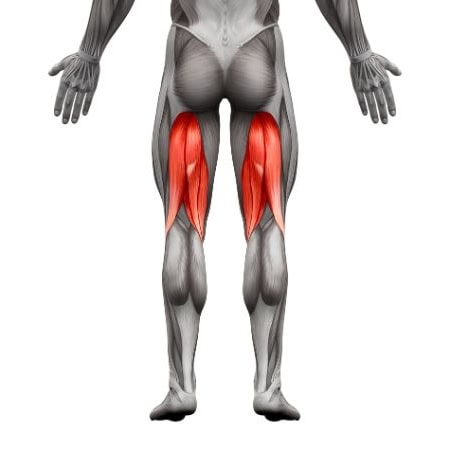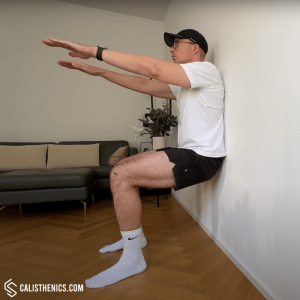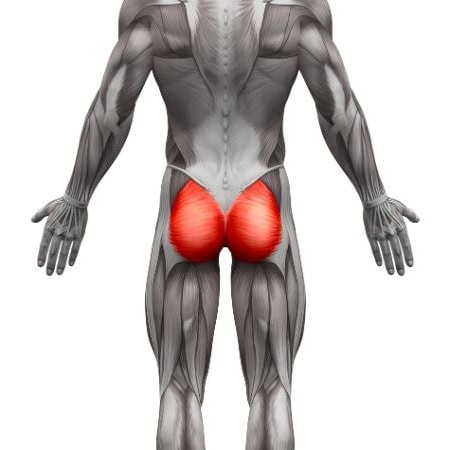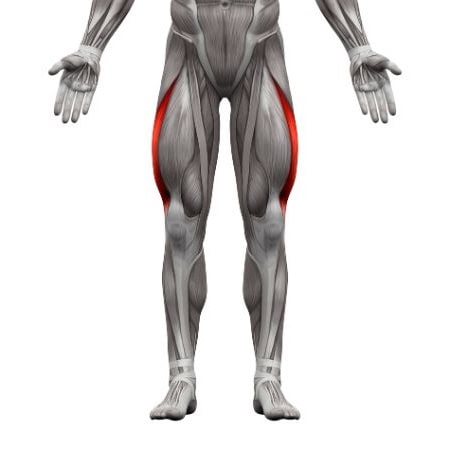Wall Sit
How to do Wall Sit?
A wall sit is a static exercise that targets the lower body, particularly the quadriceps, glutes, and hamstrings, by holding a seated position against a wall. This isometric movement strengthens the muscles through sustained tension, improving endurance and muscle stability. Wall sits are a simple yet effective bodyweight exercise that requires no equipment, making them ideal for building lower-body strength and endurance without high-impact movements.
Steps to Perform a Proper Wall Sit:
1. Find a Flat Wall:
• Stand with your back against a flat wall, with your feet about shoulder-width apart and positioned roughly 2 feet in front of the wall.
• Keep your back pressed firmly against the wall with your arms relaxed at your sides.
2. Lower into the Sitting Position:
• Slowly slide down the wall by bending your knees, lowering your body until your thighs are parallel to the ground and your knees are at a 90-degree angle. Your knees should be aligned with your ankles, and your feet flat on the ground.
• Ensure your back stays flat against the wall, and your hips are in line with your knees.
3. Engage Your Core and Hold:
• Engage your core by tightening your abdominals to stabilize your body and prevent your lower back from arching.
• Keep your arms relaxed by your sides or cross them over your chest without pushing off the wall or using them for support.
4. Hold the Position:
• Hold the seated position for the desired amount of time, typically starting with 20-30 seconds and gradually increasing as your strength improves.
• Focus on keeping your back flat against the wall and your knees in line with your ankles throughout the hold.
5. Finish the Exercise:
• When you’ve completed the hold, slowly push through your heels to stand up, using your legs to return to a standing position in a controlled manner.
Benefits of Wall Sits
• Builds Lower Body Strength: Wall sits primarily target the quadriceps, glutes, and hamstrings, helping to build strength and endurance in the lower body.
• Improves Muscular Endurance: Holding the seated position for extended periods challenges the muscles to maintain tension, improving overall muscular endurance.
• Enhances Core Stability: By engaging the core to stabilize the torso, wall sits help improve core strength and stability, which is essential for good posture and overall movement efficiency.
• Promotes Knee and Hip Stability: Wall sits help strengthen the muscles around the knees and hips, improving joint stability and reducing the risk of injury during other movements like squats, lunges, and running.
• No Equipment Needed: Wall sits require no equipment, making them a convenient exercise that can be done anywhere, whether at home, in the gym, or while traveling.
• Low Impact: This exercise is gentle on the joints, making it suitable for individuals with knee or back issues or those recovering from injury.
• Great for Beginners: Wall sits are accessible to all fitness levels and are a great way for beginners to build foundational lower body strength.
Common Mistakes to Avoid
• Letting the Knees Extend Over the Toes: Ensure that your knees remain directly over your ankles and don’t extend past your toes. This helps prevent unnecessary strain on the knee joints.
• Rounding or Arching the Back: Keep your entire back, especially your lower back, pressed firmly against the wall. Avoid letting your back round or arch, which can place strain on your spine and reduce the effectiveness of the exercise.
• Holding Your Breath: Remember to breathe steadily throughout the hold. Holding your breath can increase tension in your body and make it more difficult to maintain proper form.
• Resting Hands on the Thighs: Avoid using your hands to push on your thighs for support. Keep your hands by your sides or crossed over your chest to ensure the lower body does the work.
Tips for the proper execution of Wall Sit
Knee Alignment: Ensure your knees are directly over your ankles, forming a 90-degree angle. Avoid letting your knees cave inward or extend past your toes, which can put stress on the knees.
Back Against the Wall: Keep your entire back, especially your lower back, pressed firmly against the wall. This helps maintain proper posture and reduces strain on your spine.
Weight Distribution: Distribute your weight evenly across your feet, with a slight emphasis on your heels to engage your glutes and quads more effectively.
Breathing: Maintain steady breathing throughout the hold. Inhale deeply through your nose and exhale through your mouth to help stay relaxed and focused.
Muscles worked when doing Wall Sit
Primary Muscles:
•Quadriceps: The primary muscle group targeted during wall sits, engaged to maintain the static squat position.
•Glutes: The gluteus maximus and medius work to stabilize the hips and support the thighs during the hold.
•Hamstrings: Assist in stabilizing the knees and maintaining the seated position.
Secondary Muscles:
•Core: Abdominals and obliques are engaged to stabilize the torso and prevent your lower back from arching.
•Calves: Engaged to help stabilize the lower legs and support the static position.
•Lower Back: Erector spinae muscles help support the spine and maintain proper posture against the wall.
Primary Muscle(s):
Secondary Muscle(s):

Hamstring
Equipment needed for Wall Sit
No equipment needed for this exercise.
Adjust the difficulty of Wall Sit
How to make Wall Sit harder?
How to make Wall Sit easier?
How to make Wall Sit harder?
To make Wall Sit harder:
-
Increase Hold Time: Gradually increase the duration of the hold, aiming for 45 seconds to 1 minute or more as you build strength and endurance.
-
Add Weight: Hold a dumbbell or weight plate in front of your chest to increase resistance and further challenge your quadriceps and glutes.
-
Single-Leg Wall Sit: Lift one foot off the ground while maintaining the seated position with the other leg. Alternate legs to increase the intensity and engage your core more deeply.
-
dd a Stability Challenge: Place a resistance band around your thighs just above the knees and press outward to add resistance, engaging the glutes more and challenging your stability.
How to make Wall Sit easier?
To make Wall Sit easier:
-
Reduce the Depth: Instead of lowering into a full 90-degree seated position, perform a partial wall sit by stopping at a higher angle, making the exercise less intense.
-
Shorten the Hold Time: Start with shorter holds (10-15 seconds) and gradually increase the duration as your strength and endurance improve.
-
Use a Support: If necessary, use a soft cushion or pillow between your lower back and the wall for additional support, reducing strain and making the exercise easier.




